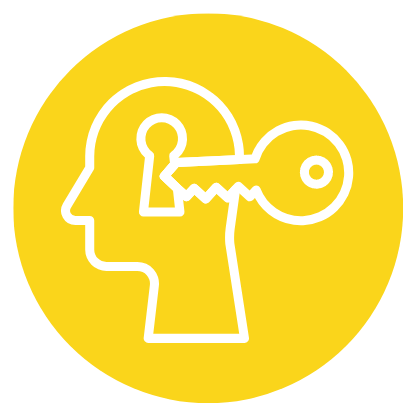The Explainer: Solving Problems By Starting With The Worst Idea | HBR
Reference: Harvard Business Review. (2019, June 11). The Explainer: Solving Problems by Starting with the Worst Idea Possible [Video]. YouTube.
We Make Your Education Count

Get the Credit You Deserve and Become the Most Attractive Job Candidate by Earning and Posting A+ Badges to Your Linkedin Profile.
Sign Up to Get Started at Accredicity
|
Unlock the secret to problem-solving: try starting with your worst idea! Solving Problems by Starting with the Worst Idea Possible - as suggested by Harvard Business Review (HBR) - might seem counterintuitive, but it's a useful tool according to designer and author Ayse Birsel. Examples like switching jobs with a junior staffer or intern, spreading good rumors instead of negative gossip, dedicating a mistake lab to celebrating and learning from failure, and having a no technology day can help to pivot dreadful ideas into brilliant ones. It can also empower junior employees, help to get over fear of failure and remind everyone of the importance of face-to-face conversations. Learning Outline1. Start with the worst possible solution to a problem you are facing at work. Instructional ContentChallenges at work can be tricky to solve, especially when it’s difficult to think outside the box. Ayse Birsel, designer and author, suggests an unconventional method for problem-solving: “wrong thinking on purpose”. Birsel’s technique involves starting with the worst possible idea and then pivoting it into a brilliant one. For example, if you’re facing a challenge at work, you can try switching jobs with a junior staffer or intern. This seemingly silly idea actually puts you in the mindset of a beginner, allowing you to ask, listen, and learn things you wouldn’t have been able to as an “expert”. It also empowers the junior employee with fresh agency to search and experiment. Another bad idea Birsel suggests is to spread rumors about your colleagues. She suggests flipping this idea on its head to make it positive by spreading good rumors instead. This could be a great way to collectively celebrate strengths. You could also try failing—intentionally and repeatedly—in an effort to get over your fear of failure and to reinforce the concept that we learn through failure. Lastly, Birsel suggests banning technology at work for a day. This could remind everyone of the importance of face-to-face conversations and meditation without interruptions from email and social media. So the next time you’re stuck on a problem at work, give yourself permission to have an awful idea. You might just surprise yourself with a brilliant solution. Watch Ayse Birsel explain her concept of wrong thinking on purpose to learn more. Cognition
|

Ayse Birsel believes that the worst ideas can be the best ideas. It's like being stuck in a chair with no wheels and then suddenly having wheels appear. It's like being told to jump in a lake and then suddenly the lake turns into a ball pit. Birsel's concept of wrong thinking on purpose means that if you come up with a truly terrible idea, no matter how bad it is, you can use it to come up with a great solution. For example, you could switch jobs with a junior employee or intern to get a new perspective and ask different questions, or spread good rumors instead of bad ones, or intentionally fail to learn from mistakes. It might sound crazy, but it could just be the best idea you've ever had. Video Quotes"Go ahead. Give yourself permission to have an awful idea. The very best one might just emerge along the way." - Ayse Birsel "Switch jobs with, say, a junior staffer or intern. It may sound silly, but this humbling 'as if' scenario can put you into an inquisitive beginner's mindset and give you a newfound permission to ask, listen, and learn things that an expert would assume they already knew." - Ayse Birsel "Maybe try failing-- intentionally, and repeatedly. Sounds like a nightmare until you pivot it to a deliberate mistake lab dedicated to celebrating and learning from failure." - Ayse Birsel Related Quotes"The worst idea is often the one that leads to the best solutions" - Adam Grant "Sometimes the worst idea is the one that gets you where you want to be" - Joe Gebbia "The best solutions are often found by exploring the worst ideas" - Jeff Weiner Competencies1. Problem Solving Learning Outcomes1. Analyze: Students will be able to evaluate and analyze the concept of "wrong thinking on purpose" and its potential usefulness in problem solving. 2. Evaluate: Students will be able to assess the concept of switching jobs with a junior staff or intern and the potential opportunities for learning it can provide. 3. Create: Students will be able to formulate creative ideas to transform negative gossip into positive rumors to celebrate their colleagues' strengths. 4. Apply: Students will be able to apply the concept of a “mistake lab” to intentionally fail and learn from the mistakes. 5. Understand: Students will be able to comprehend the benefits of having a “no technology day” to facilitate meaningful conversations and increase productivity. 6. Remember: Students will be able to recall the idea of giving oneself permission to have an awful idea and the possibility of discovering a great one in the process. Sample Answers1. In this video, designer and author Ayse Birsel explains a concept called wrong thinking on purpose. This technique involves taking a seemingly bad idea and pivoting it into a more creative and innovative solution. For example, switching jobs with a junior staffer or intern to gain a beginner's mindset, spreading good rumors instead of negative gossip, and having a no technology day to encourage face-to-face interactions. 2. Through this concept, Birsel encourages the exploration of bad ideas to come up with the best solutions. She challenges us to take risks, learn from our mistakes, and think outside the box in order to find new and innovative solutions. 3. Wrong thinking on purpose is an important problem-solving tool that can help us to think more creatively and challenge traditional solutions. By using this technique, we can come up with solutions that are more inventive and effective. HBRHBR is an American bi-monthly magazine published by Harvard Business Publishing, a wholly owned subsidiary of Harvard University. It is focused on topics related to business management and strategy. HBR is well-known for its thought-provoking content and strong emphasis on practical advice, making it a valuable resource for business professionals. The magazine has been published since 1922 and has been cited in academic journals and other publications. HBR is staffed by experts in business, finance, economics, strategy, and other topics, making it an ideal source for advice on solving problems. HBR AssessmentQ: According to Ayse Birsel, what is an example of “wrong thinking on purpose” that can help solve problems? A. Spread rumors about your colleagues Answer: C. Switch jobs with a junior staffer QuestionsCommon Hypothetical Questions: Real-Life Examples and Scenarios Questions: KeywordsWrong Thinking, "As If" Scenario, No Technology Day, Deliberate Mistake Lab, Fresh Agency, Face-to-Face Conversations, Walking Meetings, Celebrate Failure, Social Media Interruptions Facts1. Designing and author Ayse Birsel developed the concept of "wrong thinking on purpose" to solve problems in new ways. Trends1. Create a “What-If” Day – Dedicate a day each month to brainstorming and problem-solving through a “what-if” exercise. Have employees come up with their worst idea possible and then brainstorm ways to pivot it into a positive solution. 2. Host a “Failure Festival” – Instead of celebrating success, host a “Failure Festival”, where employees can share their biggest flops and learn from one another’s mistakes. 3. Launch a “Tech Free Tuesdays” Initiative – To encourage more face-to-face conversations, designate one day a week (or every other week) as a tech-free day, where all employees must leave their phones and laptops at home. 4. Start a “Rumor Mill” – Instead of discouraging rumors, launch a “rumor mill”, where employees can share positive stories and experiences about their colleagues. 5. Establish a “Mentorship Swap” – To foster collaboration and employee growth, create a “mentorship swap” program, where employees can switch roles with one another to gain new perspectives and ideas. SourceThis learning instructional guidance was formulated using the GPT-3 language model created by OpenAI. ShareBad ideas can lead to the best solutions! Embrace wrong thinking on purpose and discover new ways to solve problems. 💡 #WrongThinking #CreativeSolutions #InnovativeIdeas @Accredicity |








 224 Creds - Cognition
224 Creds - Cognition



